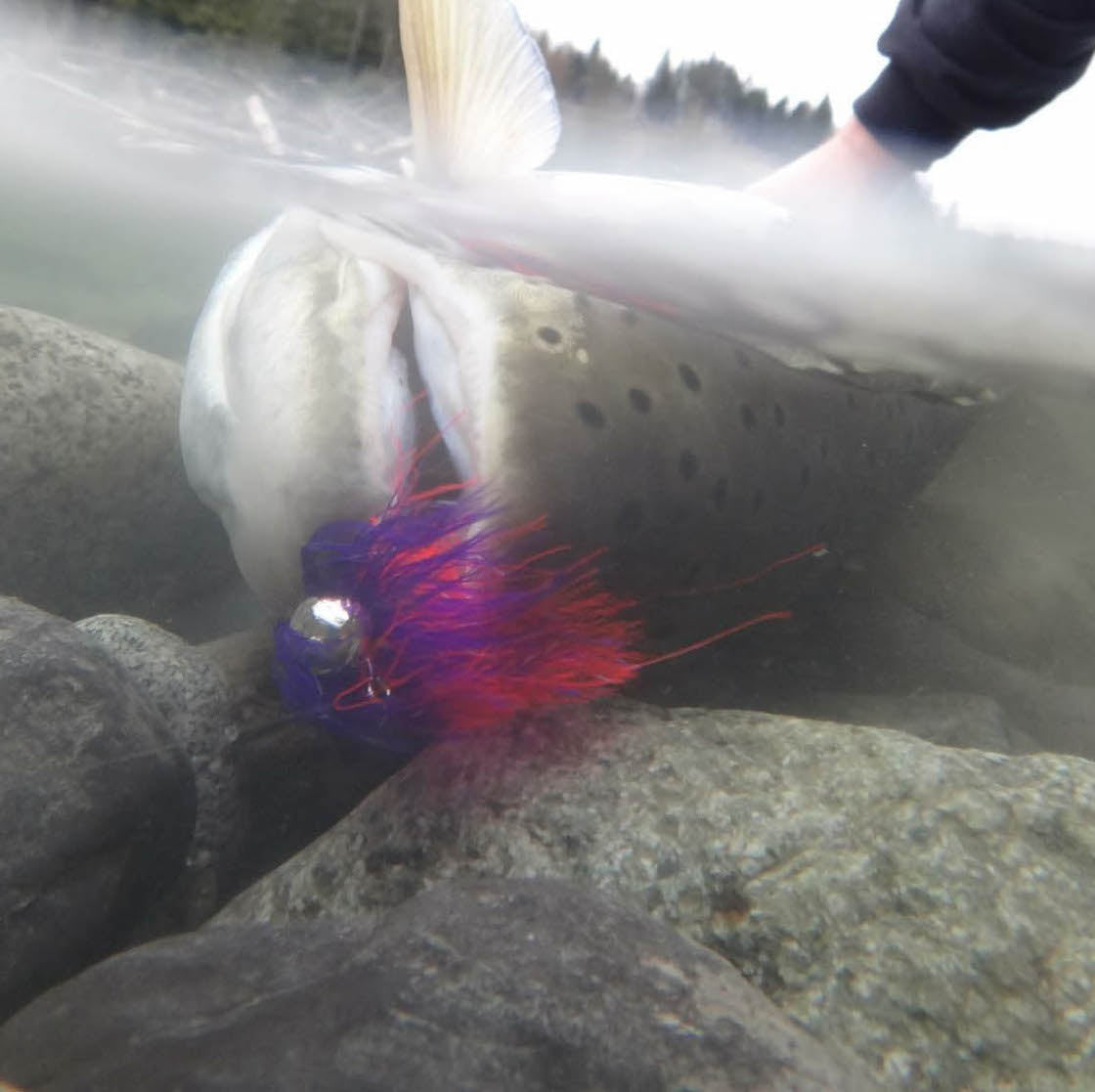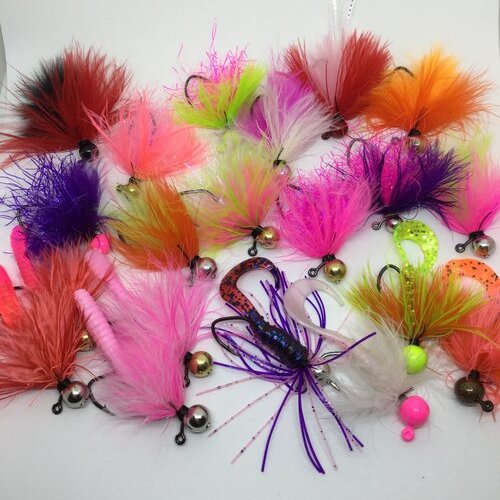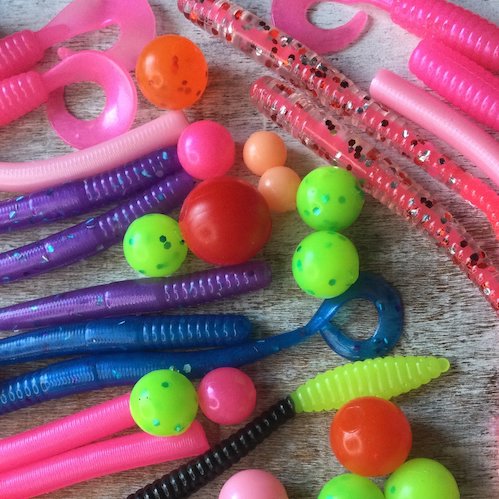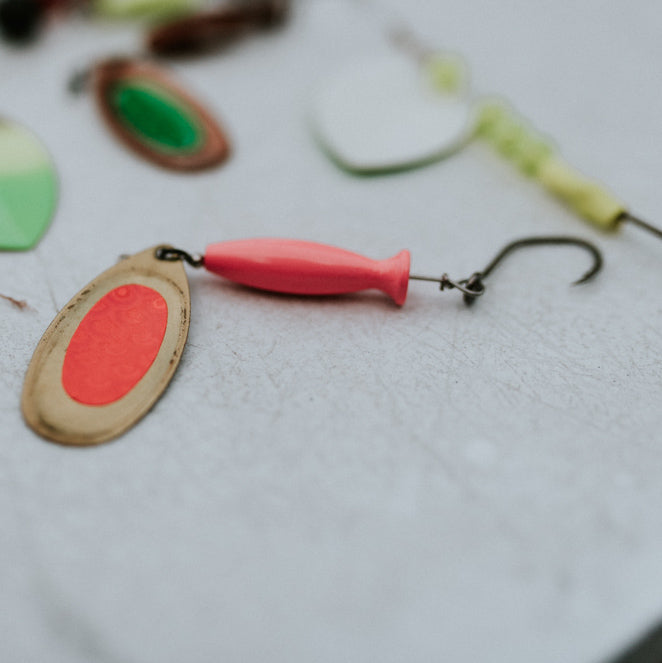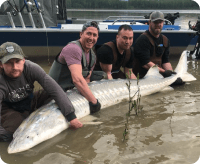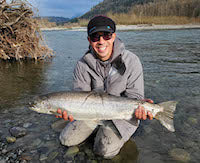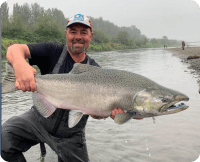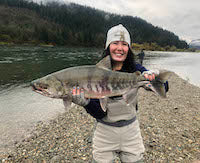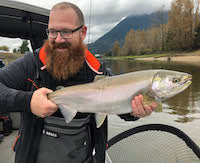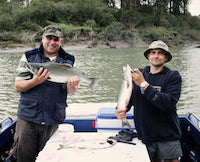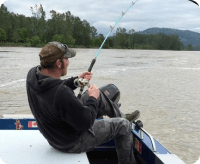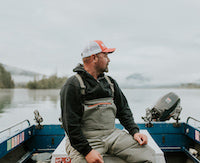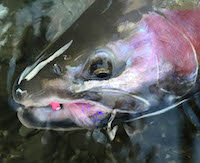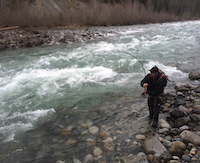Excited like a child at Christmas, I arrived at a beautiful lake in the Kamloops area. It had been more than a year since I last fished an interior lake. Adding to my excitement was the new weapon in my arsenal, my newly developed leech/grub jigs. As I set out on the water, fish were occasionally splashing and dreams of hooking my first ever Brook Trout filled my head. My plan of attack for this trip was to fly fish one of my rods rigged with a chironomid under an indicator, and the other set up with a leech/grub under an indicator.
After a few hours of fishing with only marginal success on the chronomid flies, a technique change was in order. I anchored up in a small bay and rigged my spinning rod with a 1/4 oz. lead head jig hook, adorned with a black leech. My plan was to cast the jig into the shallow water near shore and use a twitching retrieve method. On only my second cast, I was ecstatic to have a two pound Brook Trout absolutely smash the twitched jig! Thinking I had cracked the magic code to my fishing success on this lake, I was disheartened to find no other willing biters. After taking a break from the lake for lunch at the cabin, I decided to try casting off the dock for the small Trout surfacing near shore. Fast forward an hour, and I had just experienced one of the hottest hours of Trout fishing in my life! While most of the Brook Trout I caught off the dock were small (under 1 pound), a number of two pounders also grabbed the jig. Since this trip I have had success fishing these leech jigs by employing a handful of techniques.
Fly Fishing with an Indicator:
This technique is done using a fly rod, floating line, and indicator. The goal here is to suspend your leech at the depth of feeding fish. I often start by fishing my leech just off bottom. If this doesn’t produce results, I will adjust my indicator to suspend the leech at different depths until I find the zone where the fish are feeding. Most often I just cast out the leech and let it sit under the indicator, keeping a close eye on it until it pops under. Other times, I will slowly retrieve it using a succession of short strips followed by a short pause. This often triggers fish to bite.
Trolling Fly Line:
This technique is simple, and a great way to locate the feeding fish. There are numerous fly lines you can use for trolling. The water depth will determine the line you choose. I typically bring a type 6, type 7, and a slow sinking line with me. I have my best success within a range of slow trolling speeds. I vary the speed frequently to explore the productivity of various depths.
Vertically Fishing a Jig with Fly Line:
This method is performed using a full sinking fly line. A depth sounder is extremely helpful when using this method. Cast out enough line that once it sinks fully, it is vertically hanging just above bottom. Now you can either leave the jig suspended there just above bottom and wait for a bite, or you can slowly retrieve vertically back to the boat using a short, jerky retrieve. Sometimes you will find the fish feeding up closer to the surface. Starting deep and then retrieving up to the boat will help you find the best depth.
Spin Tackle with Indicator (Bobber):
Very similar to fly fishing with an indicator, this technique is very productive. I use a sliding bobber and bobber stops. I set my bobber stops to the desired depth, cast out, and let the bobber slide up the line until it stops at the desired depth as determined by your bobber stops. A great trick for finding bottom when indicator/bobber fishing, is to attach a weight to your jig. I use a 1 oz. Bouncing Betty. Let it drop to the bottom under your boat. Once you find bottom, bring up the weight a foot off bottom, and set your bobber stops. Now you are set up to fish just off bottom, often a very productive zone to find the fish.
Trolling Spin Tackle:
With this technique I use a leader. I simply tie a swivel on my mainline and run a 4 foot leader off the swivel. Tie the jig to your leader. To reach the depth I am targeting, I use split shot on my mainline above the swivel. Carry a good variety of split shot and you will soon figure out the amount needed to reach that ideal fish catching depth.
Slowly Reeling In Using Spinning Tackle:
This technique requires a 1/4 oz. lead head, a spinning reel with braided mainline, and a 4’ leader of (6 or 8 lb fluorocarbon works well). Cast your jig as far as you can, and simply retrieve the jig back to your position at a steady speed. Vary the speed to find what the fish prefer. In most situations, I would suggest allowing the jig to run close to the bottom. On the days when the fish are feeding off the bottom, a slightly quicker retrieve works best.
Twitching:
For the twitching technique, I use heavier jig heads in order to easily get the jig down to the depth of the fish. I use a spin rod and reel loaded with 10 lb braided line. I like to tie a 4’ leader to my mainline using a double uni knot. Next, I tie on a 1/8 oz, 1/4 oz (my personal favourite), or even a 3/8 oz jig head. Now cast your jig to the zone you think the fish are at. Let it sink near bottom and then perform a sharp lift, followed by a pause. This pause will allow the jig to drop which is when the fish will bite. You can watch my video on YouTube titled “Twitching for Coho Salmon” if you would like a visual example of my personal method. Once you become skilled in twitching jigs, you will find that this is one of the most productive fishing techniques available.
My good friend was fishing a famous lake near 100 Mile House and observed many large Brook Trout around some fallen trees near shore. Having little to no success with his fly rod, he looked into his tackle box and got creative with a 1/2 oz Coho twitching jig. The following hours produced a bonanza of fish including Brook Trout up to a whopping 8 lbs! This story demonstrates that being willing to think outside of the box can mean the difference between a slow unproductive day, and a magical day of hook ups for the ages!
In my many years of tying flies and jigs, I’ve come to learn the importance of movement to elicit bites. In recent years, I’ve been developing soft plastics for river fishing. While doing so, one creative experiment I had an itch to try, was a soft plastic lure that could be used in still water as well. With leeches being a key in the diet of many fish, I had a strong feeling that this would be a great place to start. Over the years I have caught all manner of Salmon and Steelhead using soft plastic curly tail grubs. With this in mind, I developed a curly tail leech grub with amazing underwater movement, and the fish seem to find it simply irresistible. While proven effective in Stillwater lakes, river and sloughs for Rainbow Trout, Brook Trout, Bull Trout, Bass, and other coarse fish… We strongly encourage you to give them a whirl in waters where you suspect they may be just the ticket! We love when people tell us about their creative and productive fishing adventures with our lures, fishing water and species we never would have known to suggest them for!

Our leech grubs come in a variety of colours, many being imitations of the leech’s natural colours. I have also created a few attractor colours. We have made them available to purchase alone, or with coordinating lead jig head, and in a multipack assortment box. I like to fish them on a jig head, but you might find a different style that works better for you. As with all of our products, our Bent Rods leech/grub jigs are only available through our website, bentrods.ca
I am very excited to hear all the success stories from anglers using our leech jigs in the many waters throughout North America!
Tight Lines & Bent Rods!
~Rod Toth



